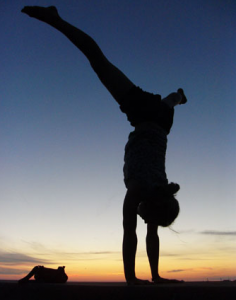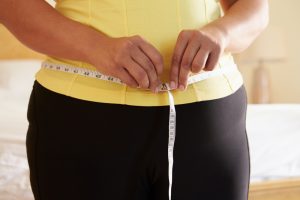Obesity is not only a risk factor for arthritis in knees and hips: “I’m not walking on my hands now am I?”

What causes obesity?
According to the Council of Public Health, obesity is the result of a combination of overeating and too little exercise. In this combination, individuals consume more calories than is necessary for the energy output of the body. The fats and carbohydrates that the body does not need as fuel for the muscles, brain and cell growth are stored in the form of adipose tissue around the muscles.
Some well-known collecting sites for these surplus fat stores are the belly, buttocks, thighs, and hips. This used to have a function. From these fat reserves, the body was able to draw energy in times when there was less food available, such as during the winter months or a famine. Now there is plenty of food, so the body does not need this emergency supply. Therefore, in the cases of an unhealthy eating and living pattern, our bodies add kilos fast, and we become overweight.
Risks of being overweight

The cartilage will wear more quickly due to overloading of the joints, which limits the freedom of movement. If this degradation process leads to serious issues, you may require surgery to treat. The surgeon will replace the worn joint with a hip or knee prosthesis. A healthy body weight therefore reduces the risk of arthritis and has an inhibiting effect on cartilage damage already present.
Obesity and osteoarthritis in the hands
In the case of overweight individuals, it is logical that the cartilage in the knees and hips will eventually wear out. However, the fact that in people with osteoarthritis the hands are also affected sounds less logical. Excess weight not only causes ‘mechanical’ damage, but also has other effects. A study by Erlangga Yusuf at the Leiden University Medical Center in the Netherlands shows just this.
This study sheds new light on the link between obesity and arthritis. He discovered that people with osteoarthritis in the hands have a lack of adiponectin. Our adipose tissue produces this substance and then the blood transports it to the joints. Scientists had previously strongly suspected that adiponectin inhibits the breakdown of cartilage and stimulates the formation of new cartilage. In the case of overweight individuals, initially production of this substance is high but not reduces over time. This can make the arthritis in the hands worse. Erlangga Yusuf concludes, however, that being overweight is still the most important risk factor in the development of knee and hip arthritis.
How to fight obesity?
To get rid of the excess kilograms, it is necessary to drastically adjust your lifestyle. That means eating healthier and exercising more. Do not be tempted by all of the slimming products in the market presented as a cure-all.
The fact that every year new slimming diets emerge, actually indicates that these products may not work as well as claimed. You can therefore save a lot of money by achieving your goals on your own. The moment you burn the first kilograms, motivation will improve
If you stick to these rules, you will certainly succeed:
- Eat three healthy meals per day. Make sure you take at least 2 ounces of vegetables and 2 pieces of fruit.
- Do not eat unhealthy and high-calorie snacks.
- Have a healthy snack or fruit halfway through the morning and afternoon and around nine in the evening. This keeps the metabolism working, so that the process of fat burning does not come to a standstill.
- Limit eating snacks, and candy, as much as possible and drink little or no alcohol.
- Every day – depending on the condition of your joints – get at least half an hour of exercise. Walking, cycling and swimming are good ways to move.
Stay at a healthy body weight
With a healthy body weight, there will be less stress on the cartilage in your joints slowing the wearing process down due to less stress. However, weight loss is not automatically permanent. Many people fall back into their old habits after a successful attempt to lose weight. They are going to eat more snacks and candy. Moreover, they become a little sloppy with physical exercise. And that is bad news for the joints. By falling back into the old way of life, the kilos will come and go.
Your body experiences the loss of fat reserves as an unnatural process. In an attempt to replenish the ’emergency ration’, it will slow down the metabolism. As a result, your body processes extra fat and carbohydrates into body fat. This is also called the ‘yo-yo effect’. It can take months for your body to get used to the new situation and the metabolism will go into higher gear again.
So, if you have lost weight, continue with a healthy diet and exercise regularly. Your joints will be thankful for that!

Share this page
Tweet

Download for free the booklet ‘Moving without pain’ with a retail value of $6.75 / £4.95.
Any questions? Please feel free to contact us. Contact us.





